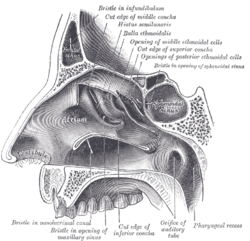Semilunar hiatus
| Semilunar hiatus | |
|---|---|
 Lateral wall of nasal cavity; the three nasal conchæ have been removed. (Third caption from the top.) | |
| Details | |
| Identifiers | |
| Latin | hiatus semilunaris |
| TA98 | A06.1.02.028 A02.1.07.018 |
| TA2 | 739, 3153 |
| FMA | 77281 75057, 77281 |
| Anatomical terminology | |
The semilunar hiatus or hiatus semilunaris, is a crescent-shaped groove in the lateral wall of the nasal cavity just inferior to the ethmoid bulla. It is the location of the openings for maxillary sinus. It is bounded inferiorly and anteriorly by the sharp concave margin of the uncinate process of the ethmoid bone, superiorly by the ethmoid bulla, and posteriorly by the middle nasal concha.
Sinus Drainage
Following the curve anteriorly leads into the infundibulum of the frontonasal duct, which drains the frontal sinus.
The anterior ethmoidal cells of the ethmoidal sinus open into the front part of the infundibulum as well. In slightly over 50% of subjects, this is directly continuous with the frontonasal duct from the frontal air sinus. When the anterior end of the uncinate process fuses with the front part of the bulla, however, this continuity is interrupted and the frontonasal duct then drains directly into the anterior end of the middle meatus.
The ostium for the maxillary sinus opens posteriorly in this groove and is the largest ostium within the semilunar hiatus.
References
![]() This article incorporates text in the public domain from page 995 of the 20th edition of Gray's Anatomy (1918)
This article incorporates text in the public domain from page 995 of the 20th edition of Gray's Anatomy (1918)
External links
- Anatomy figure: 33:04-05 at Human Anatomy Online, SUNY Downstate Medical Center
